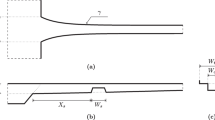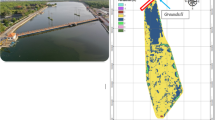Abstract
Anti-slide piles have been widely applied in many practical projects around the world. In this work, a novel upper-hollow drainage anti-slide pile (UDAP) is selected to evaluate its working performance and mechanism by means of a physical model test and a numerical simulation. The physical model test indicates that UDAPs exhibit an excellent drainage performance, and the earth pressure and the pore water pressure around them dramatically decrease. The catchment holes placed on the lateral and upslope sides of the UDAPs have the same effects, and their drainage capacity improves with depth. The numerical simulation results of the UDAP arranged in the Quchi landslide (China) indicates that the retaining effect of the UDAPs is significantly better than that of the conventional anti-slide piles (CAPs). The landslide thrust and deformation are reduced due to the decrease of groundwater table and the consequent pore water pressure reduction due to the drainage effect of the UDAPs. Furthermore, the deflection and internal force of the UDAPs are significantly lower than those of the CAPs. The retaining effect of the continuous and interval arrangement scheme of the UDAPs is almost identical. Furthermore, the value of the internal force and the law of variation of the UDAPs and CAPs are basically the same. Therefore, the results of this paper can provide an important basis for the future research, design, popularization and application of the UDAPs.




















Similar content being viewed by others
References
Aloi F, Pirone M, Urciuoli G (2019) Numerical investigation of small- and medium-diameter drain wells to stabilise deep landslides. Acta Geotech 14(3):921–921
Boon CW, Houlsby GT, Utili S (2014) New insights into the 1963 Vajont slide using 2D and 3D distinct-element method analyses. Geotechnique 64(10):800–816
Cho SE, Ee L, S R (2001) Instability of unsaturated soil slopes due to infiltration. Comput Geotech 28(3):185–208
Chung M-C, Tan C-H, Chen C-H (2017) Local rainfall thresholds for forecasting landslide occurrence: Taipingshan landslide triggered by Typhoon Saola. Landslides 14(1):19–33
Dib M, Kouloughli S, Hecini M (2019) Numerical analysis of high capacity helical piles subjected to ground movement in weathered unstable clayey slope. Comput Geotech 110:319–325
Gao Y, Yin Y, Li B, Feng Z, Wang W, Zhang N, Xing A (2017) Characteristics and numerical runout modeling of the heavy rainfall-induced catastrophic landslide–debris flow at Sanxicun, Dujiangyan, China, following the Wenchuan Ms 8.0 earthquake. Landslides 14(4):1361–1374
GB50010–2010. (2010) Code for desin of concerete stuctures. Ministry of Housing and Urban-Rural Development of the People's Republic of China ( MOHURD ), China
Gu D, Huang D (2016) A complex rock topple-rock slide failure of an anaclinal rock slope in the Wu Gorge, Yangtze River, China. Eng Geol 208:165–180
Gu DM, Huang D, Yang WD, Zhu JL, Fu GY (2017) Understanding the triggering mechanism and possible kinematic evolution of a reactivated landslide in the three gorges reservoir. Landslides 14(6):2073–2087
Guzzetti F, Cardinali M, Reichenbach P, Cipolla F, Sebastiani C, Galli M, Salvati P (2004) Landslides triggered by the 23 November 2000 rainfall event in the Imperia Province, Western Liguria Italy. Eng Geol 73(3–4):229–245
He X, Hong Y, Vergara H, Zhang K, Kirstetter P-E, Gourley JJ, Zhang Y, Qiao G, Liu C (2016) Development of a coupled hydrological-geotechnical framework for rainfall-induced landslides prediction. J Hydrol 543:395–405
Hu X, Zhang M, Sun M, Huang K, Song Y (2015) Deformation characteristics and failure mode of the Zhujiadian landslide in the three gorges reservoir, China. Bull Eng Geol Environ 74(1):1–12
Hu X, Tan F, Tang H, Zhang G, Su A, Xu C, Zhang Y, Xiong C (2017) In-situ monitoring platform and preliminary analysis of monitoring data of Majiagou landslide with stabilizing piles. Eng Geol 228:323–336
Hu X, Zhou C, Xu C, Liu D, Wu S, Li L (2019) Model tests of the response of landslide-stabilizing piles to piles with different stiffness. Landslides 16(11):2187–2200
Huang D, Gu DM, Song YX, Cen DF, Zeng B (2018) Towards a complete understanding of the triggering mechanism of a large reactivated landslide in the three gorges reservoir. Eng Geol 238:36–51
Huang D, Shi L and Cen D (2018) A semi hollow pile with drainage and anti-slide function and its construction method. No. CN106759274B China patent. Chongqing university, China
Huang D, Luo S-L, Zhong Z, Gu D-M, Song Y-X, Tomas R (2020) Analysis and modeling of the combined effects of hydrological factors on a reservoir bank slope in the three gorges reservoir area, China. Eng Geol 279:105858
Huang H, Yi W, Lu S, Yi Q, Zhang G (2016) Use of monitoring data to interpret active landslide movements and hydrological triggers in three gorges reservoir. J Perform Constr Facil 30(1):c4014005
Ito T, Matsui T (1977) Methods to estimate lateral force acting on stabilizing piles. Soils Found 15(4):43–59
Jian W, Xu Q, Yang H, Wang F (2014) Mechanism and failure process of qianjiangping landslide in the three gorges reservoir. China Environ Earth Sci 72(8):2999–3013
Jones FO, Embody DR, Peterson WL and Hazlewood RM (1961) Landslides along the Columbia River valley, northeastern Washington, with a section on seismic surveys
Kanagasabai S, Smethurst JA, Powrie W (2011) Three-dimensional numerical modelling of discrete piles used to stabilize landslides. Can Geotech J 48(9):1393–1411
Li D, Yin K, Leo C (2010) Analysis of Baishuihe landslide influenced by the effects of reservoir water and rainfall. Environ Sci 60(4):677–687
Li C, Wang X, Tang H, Lei G, Yan J, Zhang Y (2017) A preliminary study on the location of the stabilizing piles for colluvial landslides with interbedding hard and soft bedrocks. Eng Geol 224:15–28
Linden KV (1989) The Portuguese bend landslide. Eng Geol 27(1–4):301–373
Liu X-R, Kou M-M, Feng H, Zhou Y (2018) Experimental and numerical studies on the deformation response and retaining mechanism of h-type anti-sliding piles in clay landslide. Environ Earth Sci 77(5):1–14
Luo S-L, Jin X-G, Huang D (2019) Long-term coupled effects of hydrological factors on kinematic responses of a reactivated landslide in the three gorges reservoir. Eng Geol 261:105271
Martha TR, Roy P, Govindharaj KB, Kumar KV, Diwakar PG, Dadhwal VK (2015) Landslides triggered by the June 2013 extreme rainfall event in parts of Uttarakhand state. India. Landslides 12(1):135–146
Massey CI, Petley DN, McSaveney MJ (2013) Patterns of movement in reactivated landslides. Eng Geol 159:1–19
Merriam R (1960) Portuguese bend landslide, Palos Verdes Hills. California J Geol 68(2):140–153
Müller-Salzburg L (1987) The Vajont catastrophe: a personal review. Eng Geol 24(s1–4):423–444
Okeke CU, Wang F (2016) Critical hydraulic gradients for seepage-induced failure of landslide dams. Geoenviron Disaster 3(1):1–22
PoulosHarry G (1995) Design of reinforcing piles to increase slope stability. Can Geotech J 32(5):808–818
Pulko B, Majes B, Mikos M (2014) Reinforced concrete shafts for the structural mitigation of large deep-seated landslides: an experience from the Macesnik and the Slano blato landslides (Slovenia). Landslides 11(1):81–91
Ren Y, Li T, Dong S, Tang J, Xue D (2020) Rainfall-induced reactivation mechanism of a landslide with multiple-soft layers. Landslides 17(5):1269–1281
Sun G, Yang Y, Jiang W, Zheng H (2017) Effects of an increase in reservoir drawdown rate on bank slope stability: a case study at the three gorges reservoir, China. Eng Geol 221:61–69
Tang H, Hu X, Cong X, Li C, Wang L (2014) A novel approach for determining landslide pushing force based on landslide-pile interactions. Eng Geol 182:15–24
Tang H, Wasowski J, Juang CH (2019) Geohazards in the three Gorges Reservoir Area, China Lessons learned from decades of research. Eng Geol 261:105267
Tang M, Xu Q, Yang H, Li S, Iqbal J, Fu X, Huang X, Cheng W (2019) Activity law and hydraulics mechanism of landslides with different sliding surface and permeability in the three gorges reservoir area China. Eng Geol 260:105212
Usluogullari OF, Temugan A, Duman ES (2016) Comparison of slope stabilization methods by three-dimensional finite element analysis. Nat Hazards 81(2):1027–1050
Wang F, Zhang Y, Huo Z, Peng X, Araiba K, Wang G (2008) Movement of the Shuping landslide in the first four years after the initial impoundment of the three gorges dam reservoir. China Landslides 5(3):321–329
Xia M, Ren GM, Ma XL (2013) Deformation and mechanism of landslide influenced by the effects of reservoir water and rainfall, three gorges. China Nat Hazards 68(2):467–482
Xiao S (2017) A simplified approach for stability analysis of slopes reinforced with one row of embedded stabilizing piles. Bull Eng Geol Environ 76(4):1371–1382
Yan L, Xu W, Wang H, Wang R, Xie WC (2019) Drainage controls on the Donglingxing landslide (China) induced by rainfall and fluctuation in reservoir water levels. Landslides 16(8):1–11
Yi J, Shi S (2016) Research of the hollow anti-sliding pile retaining wall composite drainage technique based on large scale field test. Hydrogeol Eng Geol (In Chin) 43(6):95–100
Yi J, Zhang S, Sun J, Xian J, Cai J (2018) A comparative study of the retaining effect of hollow pile in different sections. Hydrogeol Eng Geol (In Chin) 45(05):121–128
Yu Y, Shen M, Sun H, Shan Y (2019) Robust design of siphon drainage method for stabilizing rainfall-induced landslides. Eng Geol 249:186–197
Zhang Y, Hu X, Tannant DD, Zhang G, Tan F (2018) Field monitoring and deformation characteristics of a landslide with piles in the three gorges reservoir area. Landslides 15(3):581–592
Zhao B, Wang Y-S, Wang Y, Shen T, Zhai Y-C (2017) Retaining mechanism and structural characteristics of h type anti-slide pile (hTP pile) and experience with its engineering application. Eng Geol 222:29–37
Zhao T, Utili S, Crosta GB (2016) Rockslide and impulse wave modelling in the Vajont reservoir by DEM-CFD analyses. Rock Mech Rock Eng 49(6):2437–2456
Zou Z, Lu S, Wang F, Tang H, Hu X, Tan Q, Yuan Y (2020) Application of well drainage on treating seepage-induced reservoir landslides. Int J Environ Res Public Health 17(17):6030
Acknowledgements
This work is supported by the National Natural Science Foundation of China (41972297), Supporting Program of Hundred Promising Innovative Talents in Hebei Provincial Education Office (SLRC2019027), Hebei Provincial Natural Science Foundation (D2021202002), Scientific research project from the Education Department of Hunan Province (21C0753) and Changsha Municipal Natural Science Foundation (kq2202065). The author Roberto Tomas is supported by the ESA-MOST China DRAGON-5 project (ref. 59339).
Author information
Authors and Affiliations
Contributions
DH: Supervision, Conceptualization, Methodology. YS: Validation. ZL: Data Curation, Software, Writing—original draft. SL: Supervision and review, Software. JP and RT: Editing, Validation. All authors read and approved the final manuscript.
Corresponding author
Ethics declarations
Conflict of interest
The authors declare that they have no known competing financial interests or personal relationships that could have appeared to influence the work reported in this paper.
Additional information
Publisher's Note
Springer Nature remains neutral with regard to jurisdictional claims in published maps and institutional affiliations.
Rights and permissions
Springer Nature or its licensor (e.g. a society or other partner) holds exclusive rights to this article under a publishing agreement with the author(s) or other rightsholder(s); author self-archiving of the accepted manuscript version of this article is solely governed by the terms of such publishing agreement and applicable law.
About this article
Cite this article
Huang, D., Song, Yx., Li, Z. et al. Working performance and mechanism of a novel upper-hollow drainage anti-slide pile under the effect of reservoir water fluctuation and precipitation. Acta Geotech. 18, 3799–3824 (2023). https://doi.org/10.1007/s11440-022-01775-3
Received:
Accepted:
Published:
Issue Date:
DOI: https://doi.org/10.1007/s11440-022-01775-3




